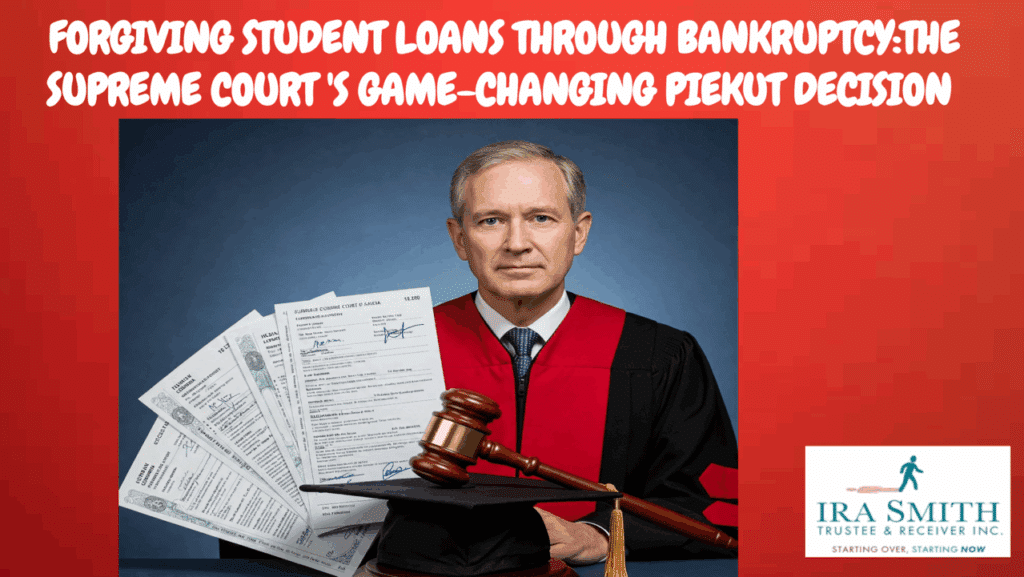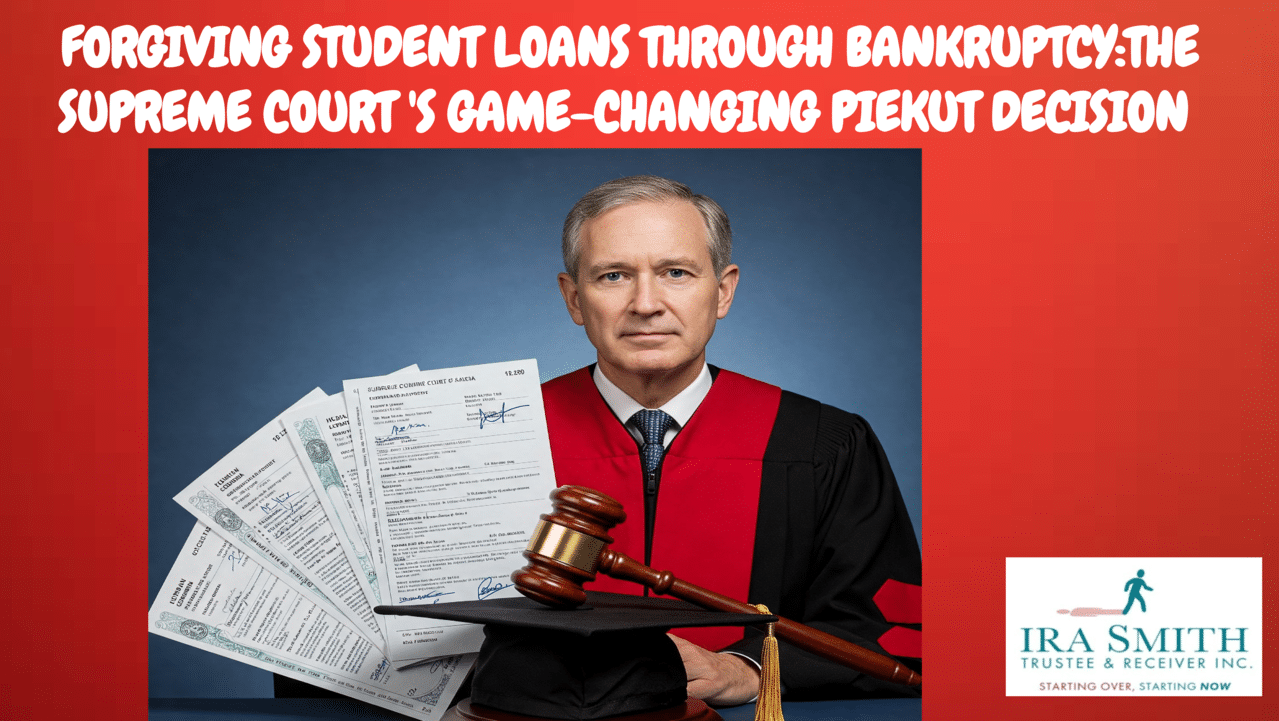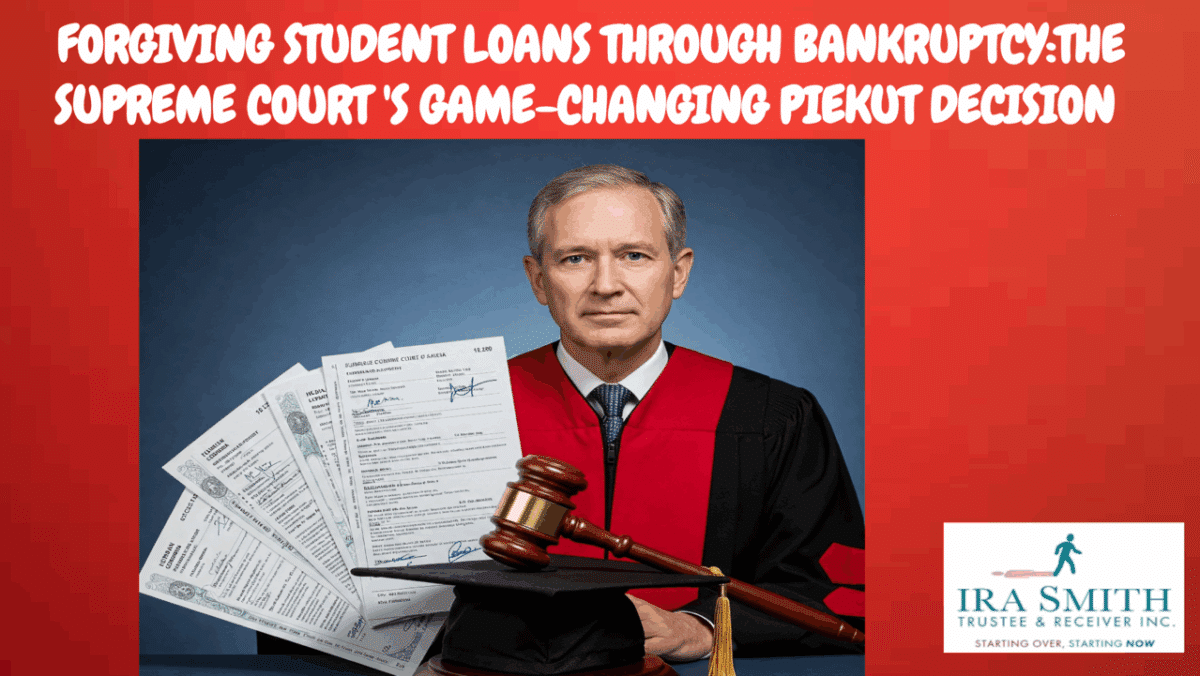forgiving student loans
Forgiving Student Loans: Introduction To The Piekut Case
Are you struggling with student loan debt in Canada? Wondering if there’s any way to get those loans forgiven through bankruptcy? You’re not alone. Many Canadians find themselves burdened by student debt long after graduation, and the path to financial freedom can seem unclear.
A recent Supreme Court of Canada (SCC) decision has changed the landscape of forgiving student loans through bankruptcy. This ruling, known as the Piekut case, affects anyone with government student loans who might be considering bankruptcy as a solution.
As a Licensed Insolvency Trustee helping Canadian consumers and entrepreneurs in the Greater Toronto Area navigate their financial challenges daily, I want to break down what this important court decision means for you in clear, simple terms.
The Basics: Student Loans and Bankruptcy in Canada
What Are Student Loans?
Before diving into bankruptcy details, let’s clarify what we mean by student loans in Canada:
Student loans are financial assistance provided by the federal and provincial/territorial governments to help Canadians afford post-secondary education. These federal loans and provincial loans typically cover:
- Tuition fees
- Textbooks and supplies
- Living expenses during your studies
Most students don’t have to make payments while studying full-time, and interest usually doesn’t start accumulating until after you finish school. This grace period is meant to give you time to find a job before repayment begins.
How Does Bankruptcy Work in Canada?
Bankruptcy is a legal process designed to help people who cannot pay their debts. When you file for bankruptcy:
- You surrender certain assets to a Licensed Insolvency Trustee
- In exchange, most of your unsecured debts are legally discharged
- You get a fresh financial start
However, not all debts are treated equally in bankruptcy. The Bankruptcy and Insolvency Act (BIA) specifies certain types of debt that cannot be easily discharged, and government student loans fall into this special category.

The Evolution of Forgiving Student Loans in Bankruptcy
The rules around forgiving student loans through bankruptcy have changed several times over the years:
Before 1997: The Early Days
In this period, student loans were generally treated like other unsecured debts in bankruptcy. If you declared bankruptcy, your student loans could be discharged along with your other debts.
1997: The First Restriction
The government introduced a rule that student loans couldn’t be automatically discharged if you went bankrupt within two years of finishing school. This was the beginning of special treatment for student loans in bankruptcy law.
1998: Tightening the Rules
Just a year later, the waiting period was extended dramatically, from two years to ten years. This meant you had to wait a full decade after finishing school before your student loans could be discharged through bankruptcy.
2005: Finding Middle Ground
In 2005, the government eased the restrictions somewhat:
- The non-discharge period was reduced from ten years to seven years
- A hardship provision was added, allowing people to apply for relief after five years
These changes attempted to balance the government’s desire to protect taxpayer-funded loan programs with the need to give struggling borrowers a path to financial recovery.
The Current Rule: The Seven-Year Wait
Today, the impact on forgiving student loans under section 178(1)(g)(ii) of the BIA is:
Your government student loans will not be automatically discharged through bankruptcy if you file within seven years after you ceased being a full-time or part-time student.
Simple enough, right? Not quite. The challenge has been determining exactly when that seven-year clock starts ticking, especially for people who return to school multiple times.

The Big Question: When Does Someone “Stop Being a Student”?
This is where things get complicated, and where the Piekut case becomes so important.
Imagine this scenario: You attend university for a few years and take out student loans. Then you work for a while before deciding to go back to school for additional education (maybe with or without taking out more loans). Later, you find yourself in financial trouble and consider bankruptcy.
When does the seven-year period begin in this situation? After your first period of study ended? Or only after your final period as a student?
Two Competing Interpretations
Before the SCC’s decision, courts across Canada were split between two different approaches:
The “Single-Date” Approach
Courts in Quebec and British Columbia followed the “single-date” approach, which says:
- There is only one date when you “ceased to be a student” for bankruptcy purposes
- That date is the very last time you were a student before filing for bankruptcy
- Even if you had long gaps between periods of study, the seven-year clock only starts after your final period of education
The “Multiple-Date” Approach
Courts in Ontario and Newfoundland and Labrador used the “multiple-date” approach, which argues:
- You can have several dates when you “ceased to be a student”
- Each date corresponds to the end of a different program or period of study
- The seven-year clock for loans from earlier periods can start running even if you return to school later
These different interpretations created confusion and inconsistency across Canada. The SCC needed to decide which approach was correct.
Meet Ms. Piekut: The Case That Made It to the SCC
Izabela Piekut’s situation perfectly illustrates why this legal question matters. Here’s her educational timeline:
- 1987-1994: Post-secondary education (with federal student loans)
- 1994-1995: More post-secondary education (with federal student loans)
- 2002-2003: Further post-secondary education (with federal student loans)
- 2006-2009: Another program (self-funded, no new loans)
- October 2013: Filed a consumer proposal listing her student loan debt
Ms. Piekut argued that she “ceased to be a student” in 2003, the last time she received government student loans. Since she filed her consumer proposal in 2013, more than seven years had passed since that date, and she believed her loans should be eligible for discharge.
However, the government argued that she remained a student until 2009, when she completed her final program. Since only four years had passed between 2009 and her 2013 consumer proposal, her student loans would not be eligible for discharge.
The courts in British Columbia sided with the “single-date” approach, but because courts elsewhere in Canada were using different interpretations of the same law, Ms. Piekut took her case all the way to the Supreme Court of Canada.

Forgiving Student Loans: What the SCC Considered
The SCC didn’t just look at Ms. Piekut’s specific situation. They examined several important factors to determine the correct interpretation of the law:
The Wording of the Law
The judges carefully analyzed section 178(1)(g)(ii) of the BIA, focusing on key phrases like “the date” and “ceased.” They also compared the English and French versions of the law to look for additional clarity.
The Context of the Law
They considered how this section fits with other parts of the BIA, particularly section 178(1.1), which allows for a hardship application after five years.
The Purpose Behind the Law
The Court examined why Parliament created these special rules for student loans in the first place:
- To reduce government losses from student loan defaults
- To ensure student loan programs remain sustainable for future students
- To give graduates a reasonable time to use their education to secure employment and repay their loans
- To discourage people from using bankruptcy solely to avoid repaying their student loans
The Practicalities of Student Loan Programs
The Court also considered how federal and provincial student loan programs operate, including their definitions of full-time and part-time student status.
The SCC’s Decision On Forgiving Student Loans: The “Single-Date” Approach Wins
In its decision released on April 17, 2025, the majority of the SCC judges sided with the “single-date” approach. They ruled that for bankruptcy law, there is only one date when a person “ceased to be a full- or part-time student,” and that is the last date they were a student before filing for bankruptcy.
For Ms. Piekut, this meant that because she was a student until 2009 and filed her consumer proposal in 2013 (only four years later), her student loans were not eligible for automatic discharge.

Why the Court Chose the Single-Date Approach In The SCC Piekut Decision
The SCC Piekut decision listed several compelling reasons for their decision:
The Language of the Law
The Court pointed out that section 178(1)(g)(ii) uses singular terms like “the date” and “ceased,” suggesting a single, final point in time. The word “ceased” implies a permanent end to something—in this case, student status.
If someone returns to school, their status as a student hasn’t truly “ceased” in a final way until their very last period of studies ends.
Consistency with Other Parts of the Law
The Court also examined section 178(1.1), the hardship provision that allows for potential relief after five years. This section also refers to when a person “ceases to be a full- or part-time student.”
For the law to be consistent, both sections should refer to the same date—the last date of study. The French version of section 178(1.1) was particularly convincing, as it uses language that indicates a final point of ceasing to be a student.
Supporting the Purpose of the Law
The Court believed the single-date approach better fulfilled Parliament’s intentions in creating these rules. By starting the seven years after a person’s final time as a student, it:
- Gives graduates a continuous period to benefit from all their education
- Provides time to secure employment and establish financial stability
- Helps prevent people from declaring bankruptcy shortly after finishing their education, only to benefit from it later
Avoiding Unfair Situations
The Court argued that the multiple-date approach could lead to illogical results. For example, someone could have a short break between programs, and the seven-year clock for their first loans could start running even though they quickly return to school and continue enjoying student benefits.
This could potentially allow them to discharge their earlier loans even if they haven’t had a proper opportunity to repay them due to being a student for most of the time.
The Dissenting Opinion On Forgiving Student Loans: What the Minority Thought
While the majority of SCC judges agreed on the single-date approach, three judges had a different view. They argued that the seven-year period should work in a forward-looking way from each time someone stopped being a student.
These dissenting judges believed that once seven years had passed since someone stopped being a student for a particular period of study, the loans related to that period should be eligible for discharge, even if the person returned to school later.
They felt the single-date approach could lead to unfair results in some cases, where someone who has been out of school for many years could have their loans remain non-dischargeable simply because they decided to further their education.
However, despite this disagreement, the majority’s “single-date” decision is now the law across Canada.

What This Means for Canadians Looking For Forgiving Student Loans
The SCC’s decision in the Piekut case has established a clear standard for all of Canada. Here’s what it means for people with government student loans who are considering bankruptcy or a consumer proposal:
The Seven-Year Clock Starts After Your Last Studies
The seven-year period during which your government student loans cannot be discharged through bankruptcy begins only after you have finished being a student. This applies to both full-time and part-time studies under federal or provincial student loan program rules.
Returning to School Resets the Clock
If you go back to school—even if you don’t take out new student loans—the seven-year countdown will restart after you finish that latest period of study.
No Separate Timelines for Different Loans
You cannot argue that the seven years should be calculated separately for loans taken out during different periods of study. What matters is when you last stopped being a student, not when you took out each loan.
Discharging Student Loans Within Seven Years Is Difficult
Unless you can qualify for the five-year hardship provision (which I’ll discuss next), it will be very challenging to get your government student loans discharged through bankruptcy if less than seven years have passed since you were last a student.
Is There Any Hope for Earlier Relief? The Five-Year Hardship Provision For Forgiving Student Loans
Even if it hasn’t been seven years since you were last a student, there is still a possibility of getting relief from your student loan debt through bankruptcy.
Section 178(1.1) of the BIA allows you to apply to the court to have your student loans discharged if at least five years have passed since you stopped being a student.
However, this isn’t automatic. To get this relief, you need to convince the court of two things:
- You have acted in good faith in dealing with your student loan debt (meaning you’ve made reasonable efforts to repay)
- You are experiencing significant financial hardship that will continue, making it impossible for you to repay the debt
This is known as a “hardship application,” and the court has the discretion to decide whether to grant it based on your specific circumstances.
Some factors courts typically consider when evaluating hardship applications include:
- Your income and employment situation
- Your living expenses and family responsibilities
- Any medical issues or disabilities affecting your ability to work
- Your efforts to find employment in your field of study
- Previous attempts to make loan payments or negotiate repayment plans

Forgiving student loans
Common Questions About Forgiving Student Loans Through Bankruptcy
Do Private Student Loans Follow the Same Rules?
No, the seven-year rule specifically applies to government student loans (federal and provincial). Private loans from banks or other lenders are generally treated like other unsecured debts in bankruptcy and can be discharged regardless of when you finished school.
What If I’ve Consolidated My Student Loans?
Consolidating your eligible student loans doesn’t change their status under bankruptcy law. Even if you’ve combined multiple loans into one, the seven-year rule still applies based on when you last ceased to be a student.
Does Taking a Single Course Reset the Seven-Year Clock?
It depends on whether that course qualifies you as a “full-time or part-time student” under the rules of your student loan program. Generally, taking a single course wouldn’t reset the clock unless it meets the program’s definition of part-time studies.
What About Student Lines of Credit from Banks?
Student lines of credit from private financial institutions are different from government student loans. They’re typically direct loans given to eligible borrowers treated like regular unsecured debt in bankruptcy, and don’t have the same seven-year restriction.
Do I Need to Prove My Student Loan Status in Bankruptcy?
Another question addressed in the Piekut case was whether the government needs a separate court order to prove its student loan claim in bankruptcy.
The SCC clarified that the government doesn’t need to get a special court order. Student loan debts are established by law and can typically be proven with records. The government just needs to file a standard proof of claim in the bankruptcy process.
Getting Help with Your Student Loan Debt
Navigating bankruptcy and the rules around student loan debt can be overwhelming. If you’re struggling with student loans and considering bankruptcy or a consumer proposal, professional advice is essential.
As a Licensed Insolvency Trustee, I can help you:
- Understand how the Piekut decision affects your specific situation
- Determine when your seven-year period begins based on your educational history
- Consider alternatives to bankruptcy that might better suit your situation

Forgiving student loans
Beyond Bankruptcy: Other Options for Managing Student Loan Debt
While this article focuses on forgiving student loans through bankruptcy, it’s worth mentioning that there are other student loan forgiveness programs available to help Canadians manage their student loan debt:
Repayment Assistance Plan (RAP)
The federal and most provincial governments offer Repayment Assistance Plans that can:
- Reduce your monthly student loan payments
- Cover the interest portion of your loan payment
- In some cases, contribute to the principal as well
RAP is available to borrowers who are having difficulty making their loan payments due to financial hardship.
Revision of Terms
You may be able to negotiate changes to your repayment terms, such as:
- Extending your repayment period
- Making interest-only payments for a period
- Adjusting your payment schedule
Severe Permanent Disability Benefit
If you have a severe permanent disability that prevents you from working and repaying your loans, you may qualify for loan forgiveness under this program.
Some provinces offer their loan forgiveness programs for graduates who work in certain fields or in underserved areas. These typically apply to provincial portions of student loans.
Conclusion: Understanding Forgiving Student Loans After the Piekut Decision
The SCC’s decision in Piekut v. Canada (National Revenue) has provided much-needed clarity on how student loans are treated in bankruptcy. The “single-date” approach means the seven-year waiting period starts only after you complete your final period of studies.
While forgiving student loans through bankruptcy within seven years of finishing school remains challenging, it becomes possible after this period or through a successful hardship application after five years.
Understanding these rules is crucial for anyone struggling with student loan debt in Canada and considering debt relief options. The path to financial freedom may seem long, but knowing your options is the first step toward taking control of your financial future.
Remember, every financial situation is unique. A Licensed Insolvency Trustee can help you understand how these rules apply to your specific circumstances and guide you toward the best solution for your needs.
Don’t let student loan debt hold you back from building the future you deserve. With the right information and support, you can find a path forward—whether through bankruptcy after the seven years, a successful hardship application, or one of the many government assistance programs designed to help Canadians manage their student loan debt.
I hope you’ve found this forgiving student loans Brandon’s Blog helpful. If you or someone you know is struggling with too much debt, remember that the financial restructuring process, while complex, offers viable solutions with the right guidance.
At the Ira Smith Team, we understand the financial and emotional components of debt struggles. We’ve seen how traditional approaches often fall short in today’s economic environment, so we focus on modern debt relief options that can help you avoid bankruptcy while still achieving financial freedom.
The stress of financial challenges can be overwhelming. We take the time to understand your unique situation and develop customized strategies that address both your financial needs and emotional well-being. There’s no “one-size-fits-all” approach here—your financial solution should be as unique as the challenges you’re facing.
If any of this sounds familiar and you’re serious about finding a solution, reach out to the Ira Smith Trustee & Receiver Inc. team today for a free consultation. We’re committed to helping you or your company get back on the road to healthy, stress-free operations and recover from financial difficulties. Starting Over, Starting Now.
The information provided in this blog is intended for educational purposes only. It is not intended to constitute legal, financial, or professional advice. Readers are encouraged to seek professional advice regarding their specific situations. The content should not be relied upon as a substitute for professional guidance or consultation. The author, Ira Smith Trustee & Receiver Inc., and any contributors do not assume any liability for any loss or damage.




